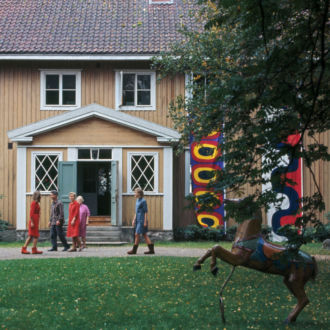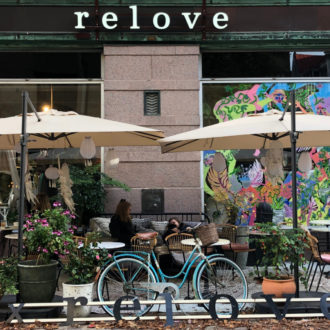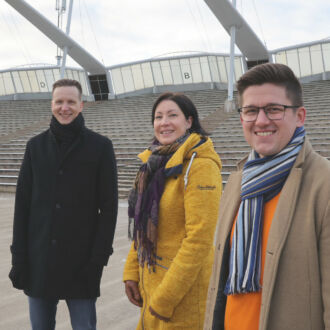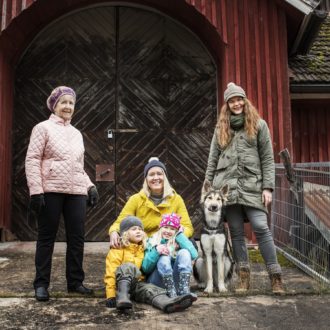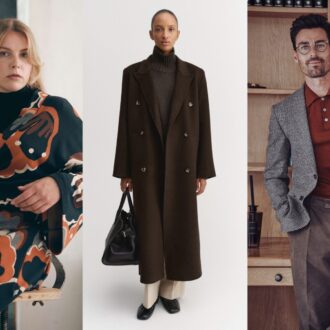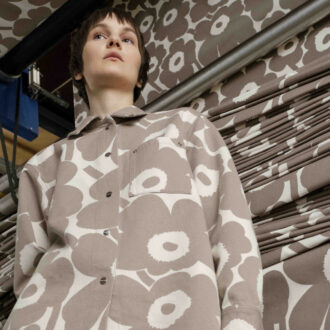Fashion designer Ervin Latimer seems to fit comfortably between high fashion and mass market. He shows his clothing at prestigious international fashion weeks, and then designs pieces for a Finnish hypermarket chain. He might host a runway show in bright red drag but considers himself pragmatic. His collections have been featured in Vogue but he doesn’t care who wears his designs.
Latimer’s clothes resemble traditional menswear silhouettes such as two-piece suits and button-up shirts, but they are designed to be worn regardless of the wearer’s gender, body shape or identity. Little tweaks make the clothes adjustable to different bodies and occasions.
“I design clothes that represent masculinity,” he says. “They’re not meant for a specific gender, but for people who want to express or perform masculinity.”
This brings us to the main tenet of Latimer’s design philosophy: he is, first and foremost, a values-driven designer. He stands for gender equality and equity, inclusivity, anti-racism and queer culture – all important parts of his identity, too, as the homosexual son of a Finnish mother and an African American father.
“Designers wield a lot of power,” Latimer says. “We share our visions of what we think people and their bodies should look like, and how they can or cannot express themselves. I feel like I am responsible for creating an inclusive and equitable vision.”
He wants people who are curious about their masculine side to look at his clothes and think, oh, I can see myself wearing this. This is for me. He also wants his clothes to be practical for sitting in a bus as well as in a limousine.
A career born out of finding one’s footing
Finnish American fashion designer Ervin Latimer talks about his design ideology (filmed at Paimio Sanatorium, a 1933 architectural masterpiece by Alvar and Aino Aalto).
Video: ThisisFINLAND
Latimer’s brand, Latimmier, was born out of the designer’s search for his place in society, wanting to see himself and his values represented in the world around him. There have always been and still are marginalised groups of people who are not as visible as others, Latimer says. Founding a creative brand was his way of positioning himself in a continuum of lesser-represented creatives in this country – and finding what Finnishness looks like for him.
It was never Latimer’s childhood dream to become a fashion designer. However, from an early age he watched his aunt effortlessly knitting jumpers and her grandmother doing crafts at home. He studied visual arts in high school, where he didn’t feel out of place in the upcycled clothes he’d bought at flea markets.
He worked in retail while studying fashion design at a university of applied sciences, and eventually got his master’s at Aalto University’s reputable fashion design programme. He also cofounded and was the managing editor of Ruskeat Tytöt Media, Finland’s first culture media for Black, Indigenous and people of colour (BIPOC).
Launching with a bang
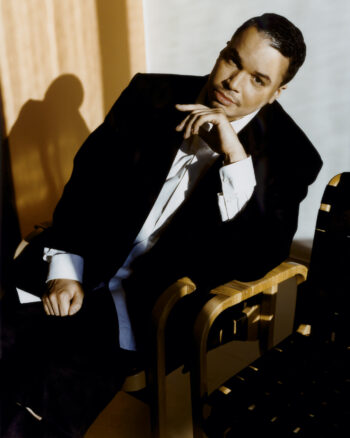
Photo: Mikael Niemi
Latimer remembers the first time he was interviewed by Finnish news outlets. Soon after showcasing his grad collection, he had been awarded the title of Finnish Young Designer of the Year, a prize given to promising design students annually since the 1990s.
He put his original twist on the competition’s theme: multifunctionality. He used his newly found platform to highlight issues he wanted to tackle in the industry:
“Usually, a body has to adapt to a piece of clothing. You must be a certain shape or size to fit in a certain piece. But what if it was the other way around? What if a piece of clothing could adapt to a person’s body?”
So he designed clothes that were adjustable, reversible and gender-neutral – aesthetic and meticulously tailored, yet wearable and approachable.
In January 2022, the Latimmier brand was launched with a bang at Pitti Uomo, the world’s leading menswear event, in Florence, Italy. Latimer took to the stage as his drag queen alter ego Anna Konda to introduce his collection.
The oversized suits with intentional slashes and gaps were designed to play with the concept of masculinity and were worn by models of different genders, body types and sexual identities. Among others, the New York Times covered the show and its roots in drag culture. Ervin Latimer had officially arrived.
Practice what you preach
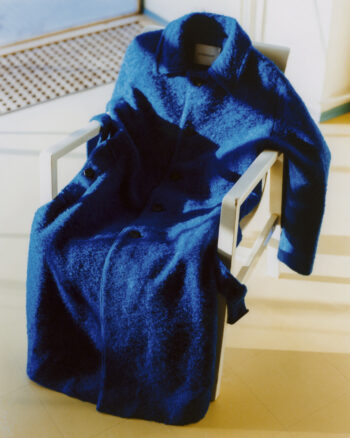
From the pages of Vogue to a Finnish hypermarket, Ervin Latimer designs clothes that work for almost any body type, gender or occasion. Photo: Mikael Niemi
Outside the spotlight, Latimer has spent a lot of time thinking about how to justify the existence of yet another clothing brand. The world doesn’t need any more textiles, he agrees. What it does need, though, are fair workplaces, sustainable working conditions and fresh air blown into an industry that’s based on exclusivity and restrictiveness. In other words, he uses his skills as a designer to implement positive change in attitudes.
“I’d like to shine a light on what happens behind closed doors in company boards and executive teams,” he says. “Who calls the shots and who profits? Who gets the opportunity to work and why? If the brand imagery is very inclusive, but the company itself isn’t, that’s not sustainable.”
Latimer practices what he preaches. He recently designed a gender-neutral collection for K-Citymarket, a hypermarket chain owned by Finnish retail giant Kesko. It was the first time in its history that the chain sold gender-neutral clothing.
The Freedom collection did what Latimer tends to do: it broke the norm. The clothes have the feel of designer clothes (sharp button-up shirts, luxurious loungewear), but they’re meant for all kinds of bodies. The collection was modelled and photographed by a diverse team, and some of the prints were designed by Finnish Guinean queer artist Gabby Electra. The clothes were made in Europe.
“According to Kesko’s survey, every second Finn occasionally buys clothes at a hypermarket,” says Latimer. “If you want to influence consumer behaviour and attitudes, you have to be where people make their purchases.”
No more burnouts
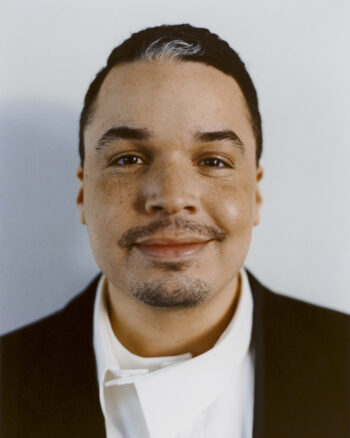
Photo: Mikael Niemi
Ervin Latimer is also a vocal advocate for humane working conditions. Having been through burnout, he doesn’t want to overwork himself or anyone else.
“I’m lucky to get to do this work on my terms, but sometimes that blinds me: I forget my boundaries. I’ve learned it the hard way, but I don’t want to make compromises when it comes to resting. At the end of the day, I’m just human,” he says.
The people he employs are fairly compensated. If that’s not possible, he doesn’t hire interns. These things might sound self-evident to a layperson but are not very common in the fashion industry.
“I’ve done internships and junior positions in big fashion houses and seen how ruthless it can be. I have a chance to do things differently. A lot of heritage brands are constantly talking about making a better tomorrow. Why wait until tomorrow, if you can improve now?”
Settling down in the country he calls home

The historical Paimio Sanatorium building: Like Latimer, architects Alvar and Aino Aalto believed great design should be accessible to all.Photo: Mikael Niemi
Latimer isn’t sure whether it is for him to say if he has found his place in the design landscape yet. He’s in his mid-30s, his brand is young, and right now he wishes he could keep doing what he does for a long time – in a way that’s sustainable in more ways than one.
Part of why Latimer likes his home country Finland so much is its infrastructure, which often makes his life easier. He has lived and worked in the US, Italy and other countries, and enjoys their big cities and opportunities. But it’s the little things here that he appreciates the most: reliability and practicality.
“Even on those Fridays when I’m exhausted after a long work week, I can always count on the bus being on time and taking me home.”
By Kristiina Ella Markkanen, ThisisFINLAND Magazine, April 2025
